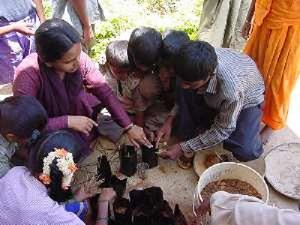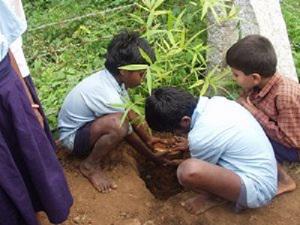Kavitha Anjanappa
The project aims at building a strong environmental ethic through focused conservation education for the rural forest fringe communities of Banneraghatta National Park.

Learning nursery techniques.
The project intends at conserving local biodiversity and related indigenous knowledge of their villages through hands on education and awareness building programs among communities adjacent to Banneraghatta National Park.

Students planting.
Initially, Biodiversity gardens in network of five forest fringe schools will be developed. I plan to define biodiversity gardens of native species attractive to butterflies and birds, with medicinal use, fruit bearing plants, along with vegetable plants, and integrate these using eco-friendly technologies like rainwater harvesting/ground water recharge and vermi-compost pits. Activities on native species like seed collection, traditional seed conserving and tree planting methods will be on my priority list. I will also train and equip students in live fencing to protect the seedlings from browsing animals and other threats.
Another important aspect of the project is involving students, teachers and local community for village resource mapping to document and restore indigenous knowledge on biodiversity conservation and traditional agriculture. Activities include documenting past and present tree diversity and their traditional uses by participatory rural appraisal techniques, developing nurseries for plants of beneficial use and distributing the seedlings for planting in areas like schools, home backyards, agri-bunds, temple land and village commons. Along with these initiatives, an informal, out of the classroom approach will be made to educate children on the ecological importance of birds and the role they play as indicators of biodiversity involving the same school students with an objective of bird identification and educating them about the ecological significance of birds and biodiversity.
The students will be introduced to the technical and scientific aspects of bird watching. Perform an assessment of the prevalent knowledge of birds and their significance, across different generations. Children will be encouraged to spread the message of conservation across their peers and different
sections of the society. Finally, will develop outreach materials in the local language and English to help build capacity of teachers and communities in the region. Outreach materials such as charts, posters, handbook, slides, power point presentations, etc., with descriptions and pictures of native plants with their traditional uses and propagation techniques, and on local birds with their pictures, description, habitats and their host plants will be developed. Also, exhibits of native seeds collected by students will be displayed. This outreach material will help in building awareness on biodiversity, its sustainable utilization, protection and management.